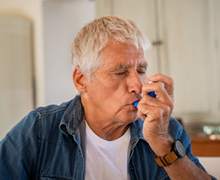
The promise to lower your blood pressure without drugs or strenuous exercise sounds like something you would hear on a late-night infomercial but a new study shows it’s possible. Researchers at the University of Colorado found strength training for your breathing muscles was able to lower systolic blood pressure and improve some measures of vascular health as much or more than regular exercise or drugs.
The process is called High-Resistance Inspiratory Muscle Strength Training (IMST) and it is accomplished by breathing through a hand-held device that causes resistance. The process of breathing in and out forces the breathing muscles to exert extra effort and as little as 5 minutes per day was found to be enough.
Researchers looking for ways to help people fend off cardiovascular disease published their findings in the Journal of the American Heart Association. They say 65% of Americans over the age of 50 have elevated blood pressure levels and less than 40% meet minimum aerobic exercise guidelines.
This breathing practice takes little time, little equipment and you can do it without going to the gym or needing to shower afterward. IMST was developed in the 1980s to help critically ill respiratory disease patients strengthen their diaphragm and other breathing muscles. It is described as sucking hard through a tube that offers resistance.
"There are a lot of lifestyle strategies we know can help people maintain cardiovascular health as they age,” said lead study author Daniel Craighead. “But the reality is, they take a lot of time and effort and can be expensive and hard for some people to access. IMST can be done in five minutes in your own home while you watch TV."
The study consisted of 36 adults who were otherwise healthy with the exception of elevated systolic blood pressure. Their ages ranged from 50-79 and their systolic pressure was 120 or higher.
Half of the group did High-Resistance IMST for six weeks and the other half had a modified protocol for a placebo. The placebo group did similar breathing work but at a much lower resistance. The study participants did not know which group they were in.
The IMST group saw their systolic pressure drop an average of nine points during that time. That’s better than other studies have shown with walking 30 minutes per day five days per week. It’s also equal to what other have achieved through pharmaceutical intervention.
The IMST results proved to be long lasting as most of the reductions were still in place six weeks after the study.
The IMST group also saw a 45% improvement in vascular endothelial function. That’s the ability of arteries to expand under stimulation. They also saw a significant increase in nitric oxide levels, a molecule that helps arteries dilate. It naturally decreases with age.
"We have identified a novel form of therapy that lowers blood pressure without giving people pharmacological compounds and with much higher adherence than aerobic exercise," said senior author Doug Seals,. "That's noteworthy."
Click here to read more in the Journal of the American Heart Association.
